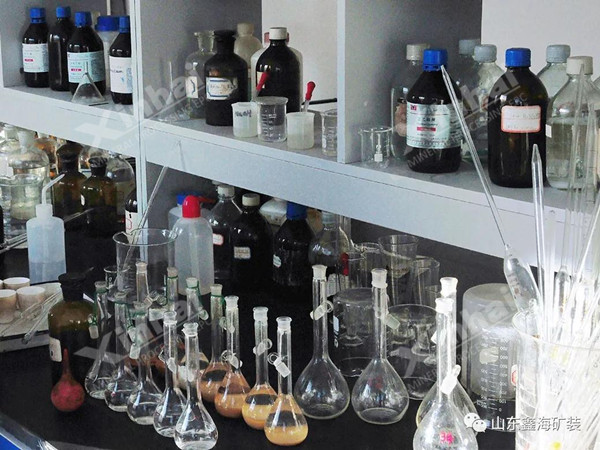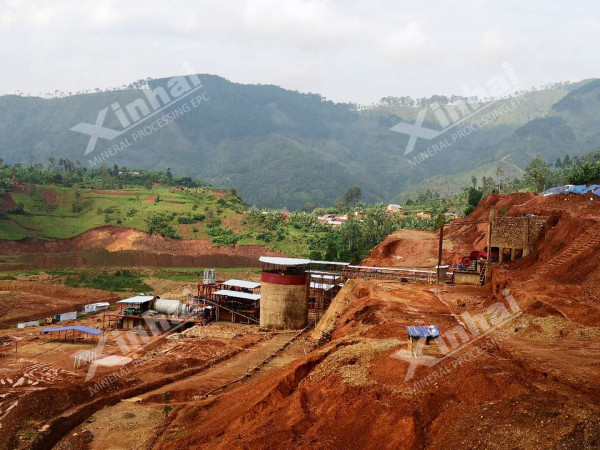The beneficiation test is very important to improve the grade and recovery rate of gold ore. This article will tell you the complete steps of gold ore beneficiation test.

The dissociation of gold monomer or the bare gold surface is a necessary condition for cyanide leaching or new non-toxic leaching, so properly increasing the grinding fineness can improve the leaching rate. However, over-grinding not only increases the grinding cost, but also increases the possibility of leachable impurities entering the leaching solution, resulting in the loss of cyanide or gold leaching agent and dissolved gold. In order to determine the appropriate grinding fineness, the grinding fineness test must be carried out first.
The pretreatment agent selection test is needed in gold ore leaching process. Usually, the commonly used pretreatment agents such as calcium peroxide, sodium hypochlorite, sodium peroxide, hydrogen peroxide, citric acid, and lead nitrate are compared with those without pretreatment under normal circumstances, in order to determine if a pretreatment selection is required.
Calcium peroxide, sodium hypochlorite, and sodium peroxide are all very stable and widely used multifunctional inorganic peroxides, and they have the characteristics of long-term oxygen release. They can slowly release oxygen in the leaching pulp for a long time, which is beneficial to improve the leaching rate of gold.
Hydrogen peroxide and citric acid provide enough oxygen during the leaching process and are the main reagents for making oxygen. The lead ions of lead nitrate (in an appropriate amount) can destroy the passivation film of gold during the cyanidation leaching process, accelerate the dissolution rate of gold, reduce the cyanidation time increases the leaching rate of gold.
In order to protect the stability of the sodium cyanide solution or the non-toxic gold leaching agent and reduce the chemical loss of the gold leaching agent, an appropriate amount of alkali must be added during leaching to maintain a certain alkalinity of the pulp. When the alkalinity is within a certain range, with the increase of alkali concentration, the amount of gold leaching agent decreases correspondingly under the condition that the gold leaching rate remains unchanged. If the alkalinity is too high, the dissolution rate and leaching rate of gold will decrease instead. Appropriate protective alkali dosage and pulp pH value. Lime is usually used as the leaching protection alkali in the test and production because of its wide source and low price, in order to determine the specific usage and provide guidance for actual production.
In the gold leaching process, the amount of gold leaching agent is proportional to the gold leaching rate within a certain range. But when the amount of gold leaching agent is too high, it will not only increase the production cost, but also impact the gold leaching rate. To this end, on the basis of the grinding fineness test, in order to further reduce the amount of gold leaching agent and the cost of production chemicals, a test of the amount of gold leaching agent is carried out to determine the appropriate amount.

In order to achieve a high leaching rate in the leaching process, the leaching time can be extended to fully dissolve the gold particles to increase the gold leaching rate. However, if the leaching time is too long, other impurities in the pulp are continuously dissolved and accumulated, which hinders the dissolution of gold. In order to determine the appropriate leaching time, a leaching time test is carried out.
During leaching, the concentration of the pulp will directly affect the leaching rate and leaching rate of gold. When the slurry concentration is too low, although the gold leaching speed and leaching rate are high, the equipment volume and equipment investment will be increased, and the dosage of gold leaching agent and other chemicals will be proportionally increased, which will increase the production cost accordingly. In order to determine the appropriate leaching pulp concentration, a leaching pulp concentration test is carried out.
For the carbon leaching method, hard and wear-resistant activated carbon must be used, so as to avoid the fine-grained carbon entering the leaching residue due to wear during the stirring leaching process, resulting in the loss of gold and reducing the recovery rate of gold. Coconut shell activated carbon is generally used in the test, with a particle size range of 6 to 40 mesh. Activated carbon pretreatment, the conditions are: water: carbon = 5: 1, stirring for 4 hours, stirring speed 1700 rpm. The activated carbon after stirring for 4 hours is then sieved with a 6-mesh and 16-mesh sieve. The fine charcoal under the sieve is removed. That is to say, activated carbon with a particle size of 6 to 16 meshes is used for carbon leaching and carbon adsorption tests.
In the gold leaching test, it is generally determined to use coconut shell activated carbon with a particle size of 6-16 mesh to absorb and recover the dissolved gold. The density of the bottom carbon directly affects the carbon adsorption rate. In order to select the appropriate bottom carbon density, the bottom carbon density test will be carried out.
In order to determine the appropriate carbon leaching (carbon adsorption) time and reduce the wear of gold-loaded carbon, it is necessary to carry out pre-leaching and carbon leaching (carbon adsorption) time tests after determining the total leaching time.
In order to verify the stability of the carbon leaching test and the repeatability of the test results, it is also necessary to carry out comprehensive verification test of the optimum condition of the above-mentioned test.
It’s advisable to consider the influence of different factors on the experimental results, and to determine the leaching conditions through a variety of beneficiation process tests. Of course, sometimes the tail water (lean liquid) return test and sedimentation velocity of carbon leaching residue test are necessary according to the needs of actual production.